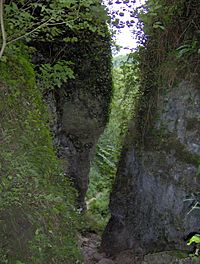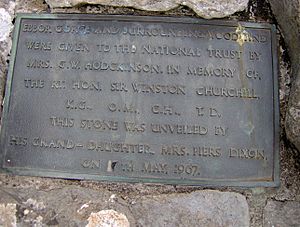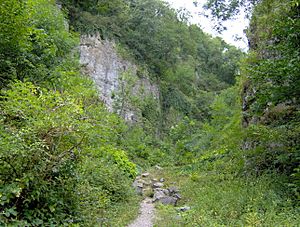Ebbor Gorge facts for kids
| Site of Special Scientific Interest | |
 |
|
| Area of Search | Somerset |
|---|---|
| Coordinates | 51°14′02″N 2°40′55″W / 51.234°N 2.682°W |
| Interest | Biological |
| Area | 156.8 acres (0.635 km2; 0.2450 sq mi) |
| Notification | 1952 |
Ebbor Gorge is a cool limestone gorge in Somerset, England. It's a very special place because of its nature and history. In 1952, it was named a biological Site of Special Scientific Interest. This means it's protected for its important plants and animals.
The gorge is located in the Mendip Hills. The National Trust was given the gorge in 1967. Now, Natural England helps look after it as a national nature reserve. Water carved out this gorge from ancient limestone. People lived here a very long time ago, leaving behind tools and pottery. Scientists have also found fossils of tiny animals. Today, Ebbor Gorge is home to many different plants and animals, like beautiful flowers, colorful butterflies, and interesting bats.
Contents
How Ebbor Gorge Was Formed
Ebbor Gorge is a steep valley cut into very old rock. This rock is called Carboniferous Limestone and is about 350 million years old. The gorge was carved by melting ice and water during the Pleistocene Epoch.
The lowest part of the gorge has different types of rock, like sandstone and coal. Over time, older limestones were pushed over these younger rocks. A very rare mineral called mendipite was even found at the top of the gorge.
A stream flows out of the west side of the gorge. It runs down a valley called Hope Wood. This stream then joins the main gorge. The original river that helped cut the gorge now flows underground. It comes out at Wookey Hole Caves to form the River Axe.
A Look Back in Time
People lived in the caves of Ebbor Gorge many thousands of years ago. These people were from the Neolithic period, also known as the New Stone Age. They left behind tools made of flint. You can see some of these tools at the Wells and Mendip Museum. A special flint flake is also on display at King John's Hunting Lodge in Axbridge.
In 1907, human and animal bones from the Neolithic period were found in Outlook Cave. Even older bones, from the Palaeolithic (Old Stone Age), have been discovered in Savory's Hole.
Several caves in the gorge hold important clues about the past. Bridged Pot and Gully Cave have some of the best collections of small mammal bones from the end of the last Ice Age. These include bones of animals like steppe pikas, Arctic lemmings, Norway lemmings, and different types of voles. Bones of red deer and reindeer have also been found. Later finds from the Bronze Age include pottery, a stone axe, and a flint knife.
Visiting Ebbor Gorge Today
About 40 hectares (100 acres) of the gorge are owned by the National Trust. Natural England manages this area as a national nature reserve. Mrs. G.W. Hodgkinson gave the land to the National Trust in 1967. She did this to remember Winston Churchill. Before that, Wookey Hole Caves Ltd bought the site in 1931.
The gorge is near Wookey Hole village and its famous caves. From the gorge, you can see amazing views across the Somerset Levels. You can even spot Glastonbury Tor in the distance.
There are three marked walking trails in the gorge. They go through the steeply wooded areas. The longest trail is 3 km long. The shortest trail is easy to use for people in wheelchairs.
Plants and Animals of the Gorge
Ebbor Gorge is a very important place for nature. Because of its special plants and animals, 63.5 hectares (157 acres) were named a biological Site of Special Scientific Interest in 1952.
The plants growing on the ground show that the soil is rich in lime. You'll find lots of dog's mercury here. Many other plants are typical of very old woodlands. Wood anemone and common bluebell are also common.
The main gorge valley is damp and humid. This makes it a perfect home for many types of fungi and ferns. Over 120 different kinds of bryophytes (small moss-like plants) have been found here. These include some very rare species.
The different ages and types of trees in the woodland attract many butterflies. You might spot rare ones like the white-letter hairstreak and the high brown fritillary. On the limestone grasslands, you can see butterflies like the chalkhill blue and brown argus.
The gorge is also a key spot for bats. Greater horseshoe bats and lesser horseshoe bats use the caves in the gorge. They use them as safe places to hibernate during winter. You can also see birds of prey flying overhead. A few red deer live here too.



